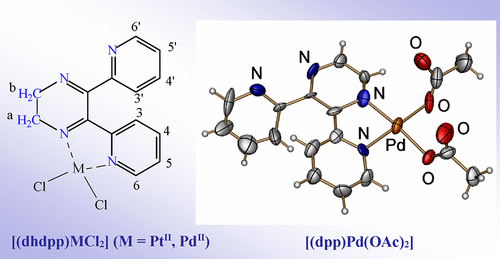当前位置:
X-MOL 学术
›
Inorg. Chem.
›
论文详情
Our official English website, www.x-mol.net, welcomes your
feedback! (Note: you will need to create a separate account there.)
Palladium(II) and Platinum(II) Mononuclear Complexes and Tendency to Undergo Dehydrogenation of the Multiple N-Donor Ligand Di-(2-pyridyl)dihydropyrazine.
Inorganic Chemistry ( IF 4.3 ) Pub Date : 2020-06-09 , DOI: 10.1021/acs.inorgchem.0c00699 Edoardo Raciti 1 , Maria Pia Donzello 1 , Elisa Viola 1 , Mauro Bassetti 1, 2 , Ida Pettiti 1 , Noemi Bellucci 1 , Corrado Rizzoli 3 , Claudio Ercolani 1
Inorganic Chemistry ( IF 4.3 ) Pub Date : 2020-06-09 , DOI: 10.1021/acs.inorgchem.0c00699 Edoardo Raciti 1 , Maria Pia Donzello 1 , Elisa Viola 1 , Mauro Bassetti 1, 2 , Ida Pettiti 1 , Noemi Bellucci 1 , Corrado Rizzoli 3 , Claudio Ercolani 1
Affiliation

|
The already known di(2-pyridyl)dihydropyrazine (dhdpp) was prepared and isolated also in the form of a bis-hydrated species, i.e., dhdpp·2H2O. As established by X-ray work, a small amount of single crystals of di(2-pyridyl)-pyrazine (dpp) was also obtained from the mother liquors, this testifying the possibility of a dehydrogenation process dhdpp → dpp in the absence of a catalyst. Using dhdpp as a ligand, mononuclear metal derivatives of formula [(dhdpp)MCl2]·xH2O (M = PdII, PtII) were obtained as stable-to-air solids, studied by X-ray powder, IR, UV–visible, and 1H NMR spectra, and proved to exhibit a N2MCl2 coordination site involving one pyridine and one pyrazine N atom (“py-pyz” coordination). An interesting relationship has been established in terms of the observed types of coordination with the analogs of di(2-pyridyl)-pyrazine (dpp) formulated as [(dpp)MCl2]·3H2O, proved also by 1H NMR spectra to exhibit the “py-pyz” mode of coordination. Attempts to isolate from the reaction of dhdpp with Pd(OAc)2 the corresponding mononuclear derivatives were shown to lead, as definitely supported by 1H NMR spectral data and crystallographic work, to the exclusive formation of the corresponding dpp complex [(dpp)Pd(OAc)2]·5H2O (“py-pyz” coordination site), this proving the tendency of dhdpp to generate dpp under different reaction conditions. The promoted conversion of dhdpp into dpp in the complex was examined by sequential NMR analysis and established to be determined by Pd(OAc)2 which plays the role of catalyst. The new salt-like species [(CH3)(dhdpp)PdI2](I)·7H2O, prepared starting from [(dhdpp)PdCl2] in its reaction with CH3I, allowed the separation from the mother liquors of small brown crystals identified on the basis of X-ray analysis as the already known complex of formula [(dpp)PdI2] (“py-py” coordination), this result once again outlining the tendency of dhdpp to be dehydrogenated to dpp.
中文翻译:

钯(II)和铂(II)单核络合物及其对多个N-配体配体二-(2-吡啶基)二氢吡嗪进行脱氢的趋势。
制备并分离出已知的二(2-吡啶基)二氢吡嗪(dhdpp),并以双水合形式dhdpp·2H 2 O的形式分离。通过X射线分析发现,少量的单晶从母液中也获得了二(2-吡啶基)-吡嗪(dpp),这证明了在没有催化剂的情况下脱氢过程dhdpp→dpp的可能性。用dhdpp作为配体,获得了对空气稳定的式[(dhdpp)MCl 2 ]· x H 2 O(M = Pd II,Pt II)的单核金属衍生物,通过X射线粉末,红外光谱研究,紫外可见光和1 H NMR光谱,证明具有N 2 MCl 2涉及一个吡啶和一个吡嗪N原子的配位点(“ py-pyz”配位)。在观察到的与配制成[(dpp)MCl 2 ]·3H 2 O的二(2-吡啶基)-吡嗪(dpp)类似物的配位类型方面,建立了有趣的关系,这也由1 H NMR光谱证明展示“ py-pyz”协调模式。尝试从dhdpp与Pd(OAc)2的反应中分离出相应的单核衍生物,这已得到1 H NMR光谱数据和晶体学研究的肯定支持,导致了相应dpp络合物[(dpp)Pd的排他性形成]。 (OAc)2 ]·5H 2O(“ py-pyz”配位点),这证明dhdpp在不同反应条件下生成dpp的趋势。通过顺序NMR分析检查了dhdpp促进的向dpp的转化,并通过Pd(OAc)2进行了测定,Pd(OAc)2起着催化剂的作用。由[(dhdpp)PdCl 2 ]与CH 3 I反应制得的新的盐状物质[(CH 3)(dhdpp)PdI 2 ](I)·7H 2 O,使其与母液分离X射线分析鉴定出的棕色细小晶体,其分子式为[(dpp)PdI 2](“ py-py”配位),该结果再次概述了dhdpp脱氢为dpp的趋势。
更新日期:2020-07-06
中文翻译:

钯(II)和铂(II)单核络合物及其对多个N-配体配体二-(2-吡啶基)二氢吡嗪进行脱氢的趋势。
制备并分离出已知的二(2-吡啶基)二氢吡嗪(dhdpp),并以双水合形式dhdpp·2H 2 O的形式分离。通过X射线分析发现,少量的单晶从母液中也获得了二(2-吡啶基)-吡嗪(dpp),这证明了在没有催化剂的情况下脱氢过程dhdpp→dpp的可能性。用dhdpp作为配体,获得了对空气稳定的式[(dhdpp)MCl 2 ]· x H 2 O(M = Pd II,Pt II)的单核金属衍生物,通过X射线粉末,红外光谱研究,紫外可见光和1 H NMR光谱,证明具有N 2 MCl 2涉及一个吡啶和一个吡嗪N原子的配位点(“ py-pyz”配位)。在观察到的与配制成[(dpp)MCl 2 ]·3H 2 O的二(2-吡啶基)-吡嗪(dpp)类似物的配位类型方面,建立了有趣的关系,这也由1 H NMR光谱证明展示“ py-pyz”协调模式。尝试从dhdpp与Pd(OAc)2的反应中分离出相应的单核衍生物,这已得到1 H NMR光谱数据和晶体学研究的肯定支持,导致了相应dpp络合物[(dpp)Pd的排他性形成]。 (OAc)2 ]·5H 2O(“ py-pyz”配位点),这证明dhdpp在不同反应条件下生成dpp的趋势。通过顺序NMR分析检查了dhdpp促进的向dpp的转化,并通过Pd(OAc)2进行了测定,Pd(OAc)2起着催化剂的作用。由[(dhdpp)PdCl 2 ]与CH 3 I反应制得的新的盐状物质[(CH 3)(dhdpp)PdI 2 ](I)·7H 2 O,使其与母液分离X射线分析鉴定出的棕色细小晶体,其分子式为[(dpp)PdI 2](“ py-py”配位),该结果再次概述了dhdpp脱氢为dpp的趋势。











































 京公网安备 11010802027423号
京公网安备 11010802027423号